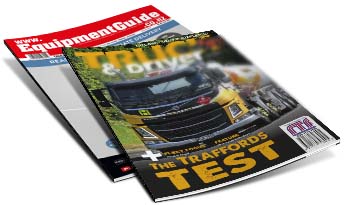Double Coin Imaging Awards


State of the art
Double Coin Imaging Awards
Nearly all of the larger Volvo trucks sold in New Zealand are built at the Volvo Group Australia plant at Wacol, Queensland.
This new Williams Salvage Volvo FM 540 8x4 which went to work in the Waikato region at the end of last year has even more Aussie input.
After rolling off the Wacol production line – complete with heavy duty double skin chassis rails, leaf spring trunnion rear suspension and hub reduction gearing – the cab and chassis moved to the Sunshine Coast headquarters of salvage and towing equipment manufacturer Ekebol.
Williams Salvage director Dion Ward-Allen says he spent a couple of years researching the build options for a new heavy tow and salvage flagship in the Frankton-based fleet.
Nearly all of the larger Volvo trucks sold in New Zealand are built at the Volvo Group Australia plant at Wacol, Queensland.
This new Williams Salvage Volvo FM 540 8x4 which went to work in the Waikato region at the end of last year has even more Aussie input.
After rolling off the Wacol production line – complete with heavy duty double skin chassis rails, leaf spring trunnion rear suspension and hub reduction gearing – the cab and chassis moved to the Sunshine Coast headquarters of salvage and towing equipment manufacturer Ekebol.
Williams Salvage director Dion Ward-Allen says he spent a couple of years researching the build options for a new heavy tow and salvage flagship in the Frankton-based fleet.
Dion weighed up several European and American manufacturers but the ability to spec the Volvo FM as he wanted and then have the salvage gear installed nearby in Queensland was the best choice.
The FM was ordered in February 2023, and the truck was landed in New Zealand in September 2024 ready for the final stages of its fit-out.
“Ekebol do a great job and it’s easy to jump on a plane across to Queensland and talk through all of the details,” Dion says.
“They [Ekebol] specialise in all sorts of recovery vehicles – heavy salvage, tilt and slide decks. They’ll do whatever you want up to about 150-tonne rating.”
The 13-litre 8x4 with 12-speed I-shift automated transmission is rated at 100t GCM. With a 22t GVM the unit has the capacity to tow 78t. Hub reduction gearing helps with the heaviest work and steep terrain.
There’s a key reason for choosing the 540hp engine.
“We could have gone for more power but all of the Volvo models with more power come with the bigger cabs. The lower cab is good for us because we sometimes have to work in places with low overhanging trees,” Dion says.
The salvage gear on the Volvo is Ekebol’s TS22 long boom set-up with the twin 24t winches being positioned well forward – just behind the second steer axle – for the best weight distribution.
“We went for the trunnion rear suspension. It’s tried and tested and tough as nails,” says Dion.
The truck responds to breakdowns, attends accidents and does some occasional heavy haul support work.
“No two jobs are the same,” says Dion.
“But the majority of the work is moving broken down trucks with the underlift.”
A push bar also allows the Volvo to team up with heavy haul units if required.
The Volvo carries the registration number HVITOW and becomes the flagship for the Williams Salvage fleet of 16 trucks - ranging from 3t flat decks up to the new Volvo working primarily in the wider Waikato region (which means across the Coromandel and down to the Waitomo regions).
The final part of the project brought some Kiwi input into the build process
“We got plenty of set-up help from Truck Towing NZ in Palmerston North and Ken Baird hand-painted the old school Heavy Tow signage as well as the scrolls and pinstripes,” says Dion.
Hamilton’s Terry Harcourt is the main driver of the Volvo and previously drove the Williams Salvage 450hp Isuzu.
“I love the Isuzu 450 and our old Isuzu with the 350 Cummins Big Cam, but this is next level,” says Terry.
“The 540hp is good and it’s got heaps of torque.”
“I’m getting used to the auto now,” says Terry.
“Even with something on the back it feels so smooth. That’s the difference to the old one – you were always bouncing around.”
In the first few months on the road Terry has been fine-tuning where the gear is carried on the Volvo.
The truck carries spill kits, crow bars, shovels, specific towing eyes for different truck brands, airlines, chains, a comprehensive tool kit, gas cutting gear and more.
“We carry a lot of stuff. When you need it, you need it,” Terry says.
The Volvo has multiple storage lockers along each side with a central locking function.
“We’ve been working on where to put everything,” says Terry.
“Mainly, all the stuff you use on a regular basis we put on the left hand side, so you are less likely to be working from the traffic side. The stuff we use less often is on the driver’s side.”
Both the boom and underlift can be operated from a remote control or from dual control panels – one on each side of the truck. Another feature is a rear facing camera mounted on the roof, just behind the beacons which is helpful for backing into tight spots.
Dion expects to get many years of service out of the new Williams Salvage flagship.
“The last time the company put on a new big truck was the Isuzu in 2003. I look at this as a 15-year investment,” he says.
“The truck doesn’t travel a big mileage. We are a reactive industry, and we are ready to go 24/7.”



 + EQUIPMENT GUIDE - FREE
+ EQUIPMENT GUIDE - FREE
